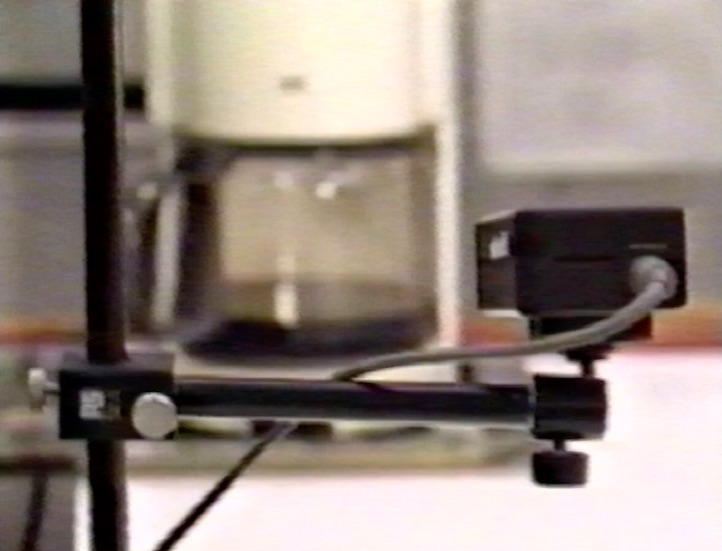I
How the world’s first webcam made a coffee pot famous!
Computer technology now moves so fast it’s hard to remember life before the internet. But at the beginning of the nineteen nineties, the fledgling world wide web had no search engines, no social networking sites, and no webcam.
The scientists credited with inventing the first webcam – thereby launching the revolution that would bring us video chats and live webcasts – stumbled upon the idea in pursuit of something far more old-fashioned: hot coffee.
As computer geeks at the University of Cambridge beavered away on research projects at the cutting edge of technology, one piece of equipment was indispensable to the entire team – the coffee percolator.
The story of the Trojan room coffee pot camera as told by Quentin Stafford- Fraser. He was one of the team that created the first webcam, the Trojan room coffee pot. Quentin pointed a camera at the coffee pot and wrote the XCoffee client program which allowed the image of the pot to be displayed on a workstation screen.
The Trojan Room Coffee Pot
A (non-technical) biography
by Quentin Stafford- Fraser
“Several people have asked about the origins of the Trojan Room coffee pot. It started back in the dark days of 1991, when the World Wide Web was little more than a glint in CERN’s eye. I was working on ATM networks in a part of the Computer Lab known as the Trojan Room, (a name which, perhaps, causes some amusement to American readers). There were about fifteen of us involved in related research and, being poor, impoverished academics, we only had one coffee filter machine between us, which lived in the corridor just outside the Trojan Room. However, being highly dedicated and hard-working academics, we got through a lot of coffee, and when a fresh pot was brewed, it often didn’t last long.
Some members of the ‘coffee club’ lived in other parts of the building and had to navigate several flights of stairs to get to the coffee pot; a trip which often proved fruitless if the all-night hackers of the Trojan Room had got there first. This disruption to the progress of Computer Science research obviously caused us some distress, and so XCoffee was born.
In the Trojan Room there were several racks of simple computers used in the testing of our networks. One of these had a video frame-grabber attached and was not being used at the time. We fixed a camera to a retort stand, pointed it at the coffee machine in the corridor, and ran the wires under the floor to the frame-grabber in the Trojan Room. Paul Jardetzky (now working in California) then wrote a ‘server’ program, which ran on that machine and captured images of the pot every few seconds at various resolutions, and I wrote a ‘client’ program which everybody could run, which connected to the server and displayed an icon-sized image of the pot in the corner of the screen. The image was only updated about three times a minute, but that was fine because the pot filled rather slowly, and it was only greyscale, which was also fine, because so was the coffee.
This system only took us a day or so to construct but was rather more useful than anything else I wrote while working on networks. It also made a better topic of conversation at dinner parties than ATM protocols. The first published record of XCoffee came when Bob Metcalfe wrote about it in Comm Week on 27th January 1992 after visiting the lab, and inspired by this success, there was talk of other monitoring applications using low-frame-rate video. Systems such as XSandwichVan and XPrinterOutputTray were mooted, but the elderly frame grabber eventually gave up the ghost, Paul and I moved on to other things, and the Trojan Room coffee pot would have sunk into obscurity had not Daniel Gordon and Martyn Johnson resurrected the system, treated it to a new frame grabber, and made the images available on the World Wide Web. Since then, hundreds of thousands of people have looked at the coffee pot, making it undoubtedly the most famous in the world.”
How history remembers it.
The researchers rigged up a small Philips camera to provide the pictures
“One of the things that’s very, very important in computer science research is a regular and dependable flow of caffeine,” explains Dr Quentin Stafford-Fraser.
But the problem for scientists was that the coffee pot was stationed in the main computer lab, known as the Trojan room, and many of the researchers worked in different labs and on different floors.
“They would often turn up to get some coffee from the pot, only to find it had all been drunk,” Dr Stafford-Fraser remembers.
Nothing else I’m ever involved in again in my life will get this much coverage and it was just one afternoon’s crazy idea” Dr Quentin Stafford-Fraser
Streaming coffee.
To solve the problem, he and another research scientist, Dr Paul Jardetzky, rigged up a camera to monitor the Trojan room coffee pot. The camera would grab images three times a minute, and they wrote software that would allow researchers in the department to run the images from the camera on their internal computer network.This removed the need for any physical effort to check the coffee pot, and avoided the emotional distress of turning up to find it empty.
However, it wasn’t until 22 November 1993 that the coffee pot cam made it onto the world wide web. Once again it was a computer scientist, momentarily distracted from his research project, who made the breakthrough.
Dr Martyn Johnson was not one of those connected to the internal computer network at the Cambridge lab, and therefore had been unable to run the coffee pot cam software.
He had been studying the capabilities of the web and upon investigating the server code, thought it looked relatively easy to make it run.
“I just built a little script around the captured images,” he says.
“The first version was probably only 12 lines of code, probably less, and it simply copied the most recent image to the requester whenever it was asked for.”
And so it was that the grainy images of a rather grubby coffee pot in a university lab were written into computer science folklore, as the first ever webcam.
East of Java
“It didn’t vary very much,” explains Dr Stafford-Fraser. “It was either an empty coffee pot, or a full one, or in more exciting moments, maybe a half-full coffee pot and then you’d have to try and guess if it was going up or down.”
Word got out, and before long millions of tech enthusiasts from around the world were accessing images of the Trojan room coffee pot.
Dr Stafford-Fraser remembers receiving emails from Japan asking if a light could be left on overnight so that the pot could be seen in different time zones.
The Cambridge Tourist Information office had to direct visitors from the US to the computer lab to see it for themselves.
The coffee pot cam even got a mention on the BBC’s longest running radio soap opera – the Archers.
“I think we were all a little bewildered by it all to be honest,” confesses Dr Johnson.
“I sometimes think nothing else I’m ever involved in again in my life will get this much coverage and it was just one afternoon’s crazy idea,” adds Dr Stafford-Fraser.
Ten years and millions of hits later, the scientists wanted to move on.
“The software was becoming completely unmaintainable,” remembers Dr Johnson.
“Research software is not always of the highest quality and we simply wanted to throw away the machines that were supporting this.”
Despite a wave of nostalgic protest from webcam fans around the world, the coffee pot and the webcam were eventually switched off. The last image captured was the scientists’ fingers pressing the “off” button.
“In 10 years it had gone from being a wacky new idea, to a novelty that a reasonable number of people knew about, to a widely viewed icon of the early web, to an historic artefact, and then to something that people were mourning over when it was no longer there,” concludes Dr Stafford-Fraser.
“Only on the internet can that sort of thing happen in just a few years.”
The Trojan room coffee pot was sold at auction – predictably over the internet – for £3,350.
It was bought by Der Spiegel news magazine in Germany, which soon pressed the pot back into active service.
Your content goes here. Edit or remove this text inline or in the module Content settings. You can also style every aspect of this content in the module Design settings and even apply custom CSS to this text in the module Advanced settings.


